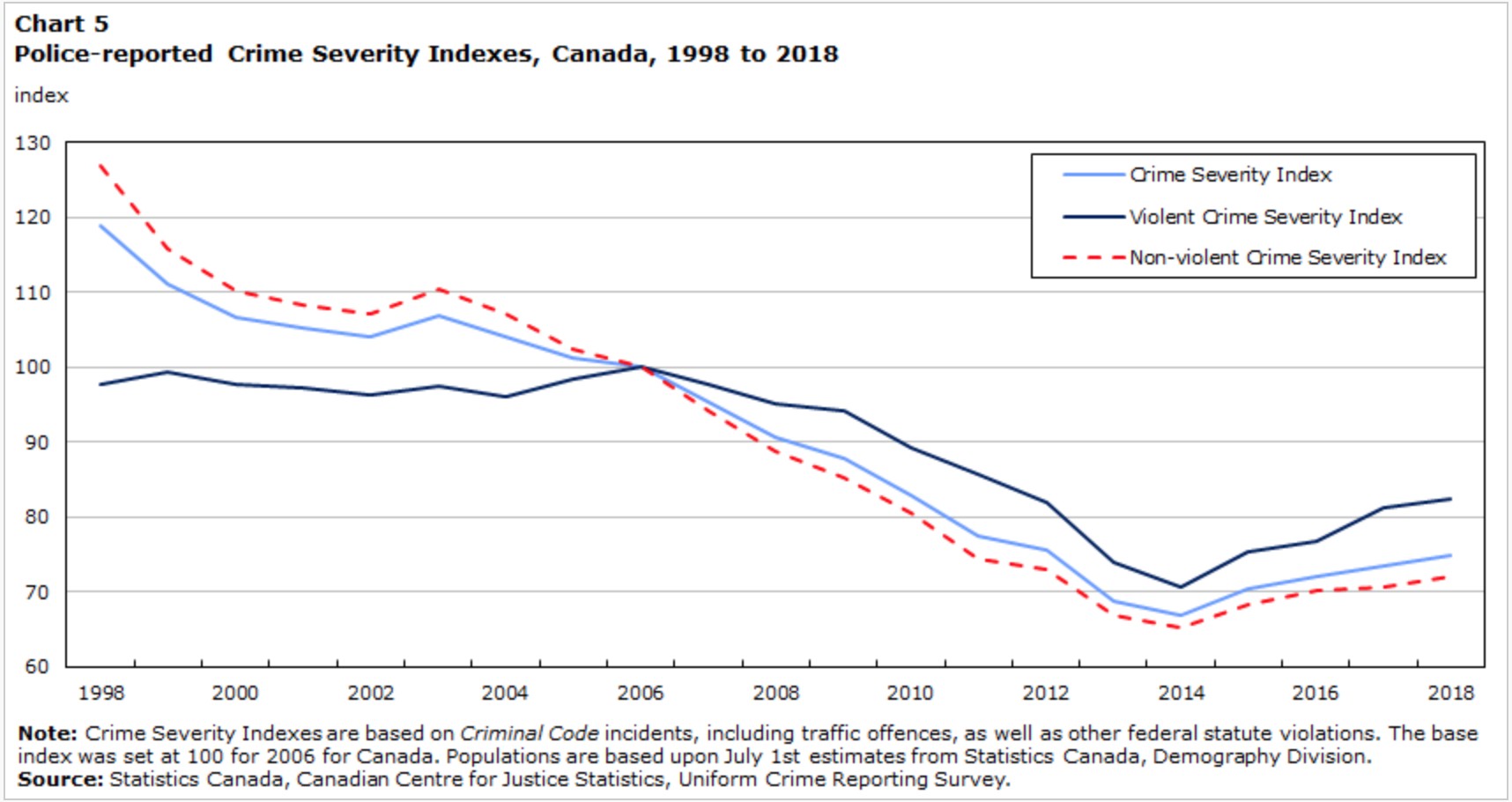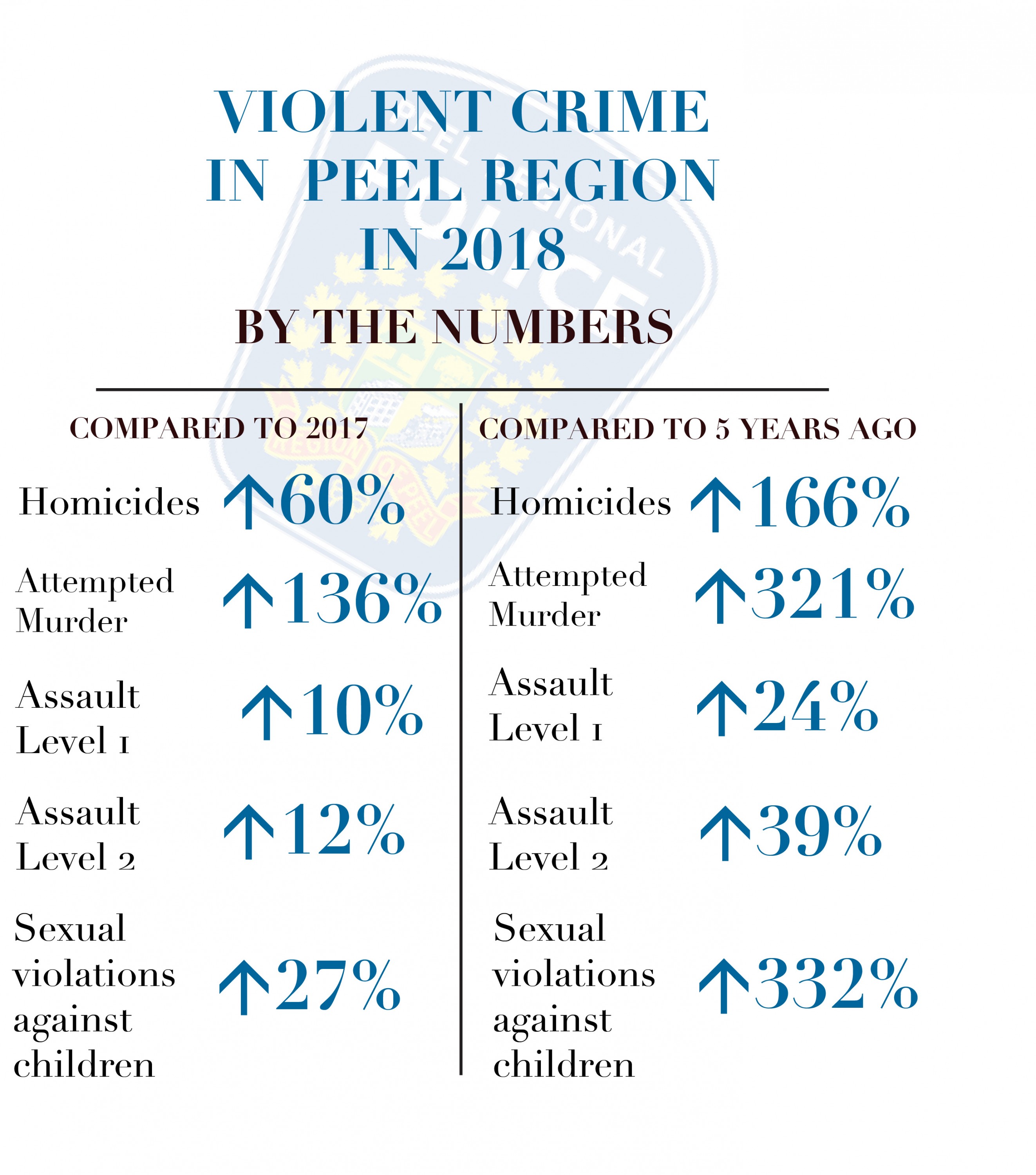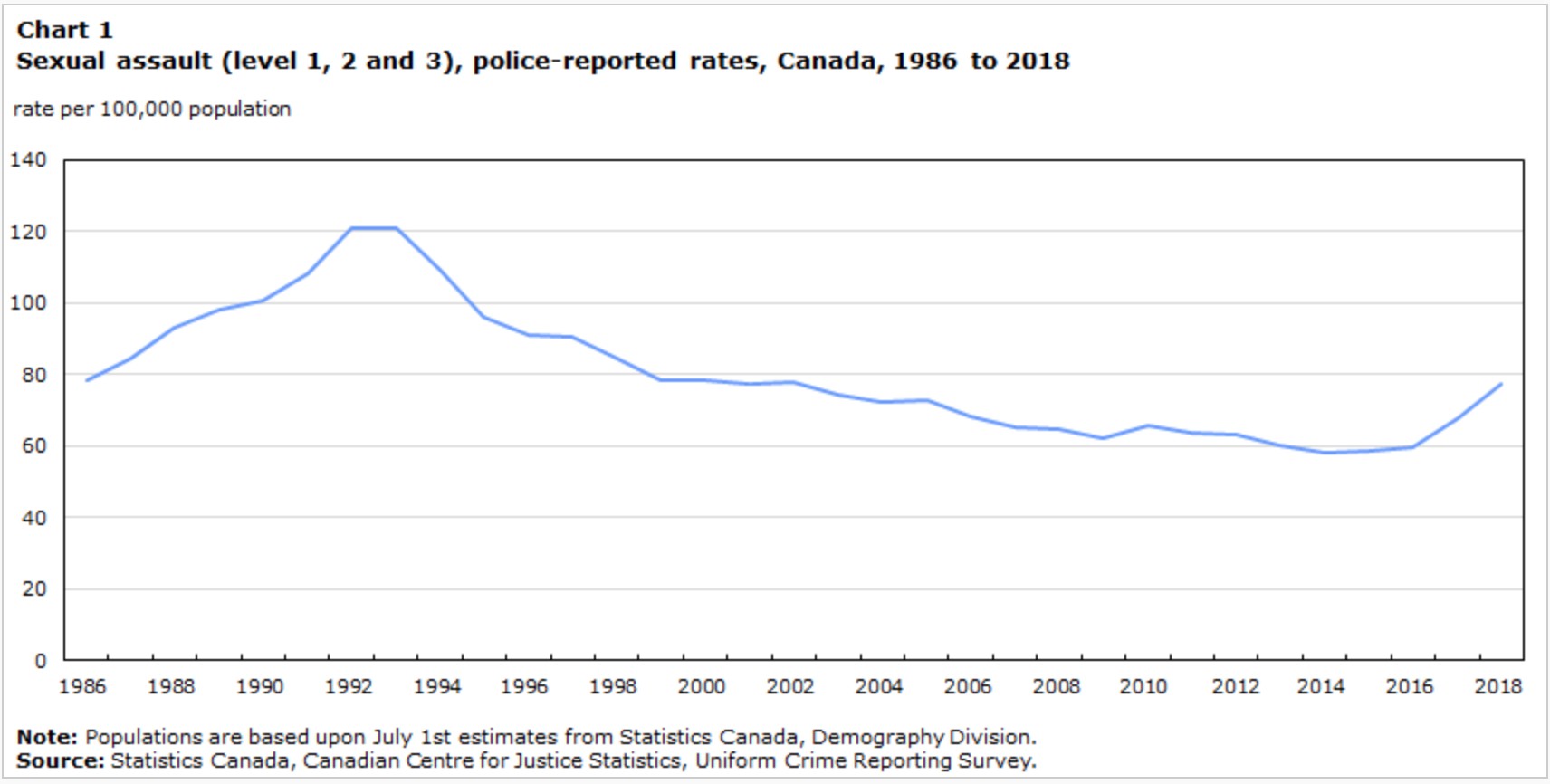
Brampton and Mississauga’s rate of increase in violent crime tripling Canada’s over last five years
It’s been a violent couple of days for Peel Region. On Thursday, police found a man in the Steeles Avenue and Tomken Road area of Brampton with signs of trauma, and he later died. Just this morning, there are reports of a stabbing that left one person dead and another in hospital.
It once again raises the question: are Brampton and Mississauga really becoming more violent?
It’s a question that was the topic of countless discussions in 2018. Social media, online forums, public town halls, and even a local crime summit were abuzz with uncertainty, worry, and strong opinions.
With Statistics Canada officially releasing national crime numbers for last year, there is fresh fuel for the fire.
According to Stats Can, the number of violent police-reported incidents of all types of violent crime increased 13 percent between 2017 and 2018. What’s more concerning is that these types of crimes have increased 33 percent since 2014, a more telling sign that the numbers represent an ongoing trend and not a statistical blip.
Additionally, the numbers show that violent crime in Brampton and Mississauga is not only increasing, but that increase is happening faster than many other parts of the country.
According to the violent crime severity index, Peel’s rate has increased a troubling 51 percent since 2014, compared to a 27 percent increase for Ontario and 17 percent for the country.
Statistics Canada uses data provided annually by police forces across the country, including Peel Region Police, which only patrol Brampton and Mississauga; Caledon is policed by the OPP. One shortcoming of the local data is that it does not distinguish between Brampton and Mississauga, lumping crime data from the two cities together. It’s possible that certain crime rates and the overall numbers in one city could be significantly different than the other, but the aggregated numbers, as provided, do not allow for such a comparison.

Broken down, the statistics in Peel provide a picture of lives ripped apart by homicides (up 60 percent from 2017), and attempted murders (up 136 percent over 2017). The numbers illustrate lives affected by all kinds of assaults, from the minor Level 1 actions (pushing, slapping, punching or face-to-face threats, up 10 percent), more violent Level 2 assaults, which typically involve a weapon (an increase of 12 percent), and perhaps permanently changed by the most violent types of assaults, also known as Level 3 or aggravated (an increase of 50 percent).
Unfortunately, it doesn’t end there. Sexual violations also increased almost across the board. Level 1 instances increased 19 percent, and Level 2, which typically involve a weapon, rose 42 percent from 2017.

Reported sexual violations against children also increased 27 percent year over year, continuing a deeply disturbing trend. Cases involving these heinous crimes against children have surged by 332 percent since 2014.
Despite those frightening increases, a consistent refrain among political leaders and police is that Brampton and Mississauga remain safe places to live, with crime numbers below provincial and national averages.
This is true. When looking at the Violent Crime Severity Index, a measure that aggregates numbers for all types of violent crime — more heavily weighing more severe types of crime — and applies a rating, Brampton and Mississauga numbers remain lower than Ontario and Canada in general.
For the country, the violence index stands at 82.44, continuing a trend of increasing violence since 2014, reflected in the numbers in Ontario and Brampton/Mississauga as well. For Ontario as a whole, the violence index has risen from 57.86 in 2014 to 73.44 last year. In Brampton and Mississauga, it has also risen over the past five years, to 69.50 in 2018.
Compared with other areas of the province or country, those numbers suggest Brampton and Mississauga are safe places to live, and for the most part this is true.
As interim police chief Chris McCord notes in the Peel Regional Police 2018 annual report, “ensuring the Region of Peel remains one of the safest communities in Canada is the result of the dedication and professionalism of our employees. The partnership and trust our Community has with our employees is central to our Vision of a Safer Community Together.”
However, these statistics alone don’t provide the full context of the changing criminal element in Peel Region. Without considering the broader trends, we may be ignoring the danger.
According to Statistics Canada, two-thirds of Canada’s Census Metropolitan Areas (CMAs) saw increases in their crime severity indexes since the benchmark year of 2014. Ontario in general has experienced a violence index increase of 27 percent.
Peel’s per capita rate of violent crime, at 620.31 per 100,000 people, is lower than the provincial average of 898.66. But again, the numbers show that Peel is quickly catching up. While Ontario’s per capita rate has increased 14 percent since 2014, Peel’s has jumped by nearly double that amount, 26 percent. This suggests that while the entire province is experiencing rising rates of violent crime, Peel is seeing it increase more quickly.
Overall, violent crime in the province has gone up by 20 percent since 2014; in Peel, 33 percent. The difference is especially acute in the most severe crimes. Homicides have gone up by 70 percent in Ontario; in Peel, 166 percent (from nine homicides in 2014 to 24 last year). In Ontario overall, attempted murders rose by 82 percent; in Peel, 321 percent. Level 1 sexual assaults increased 45 percent in Ontario, compared to 76 percent in Peel.
The startling 332 percent increase in reported sexual violations against children in Peel is more than double the Ontario increase (128 percent).

In short, the numbers are a clear warning sign that things are changing in Peel Region.
Regional Councillor Michael Palleschi, Brampton’s representative on the committee currently developing Peel’s provincially mandated Community Safety and Wellbeing Plan, told The Pointer that overall crime (including non-violent crimes against property) has actually decreased by 2 percent since 2007. However, the councillor acknowledges that more needs to be done to tackle violent crime. He points to intergovernmental collaboration as a starting point.
Palleschi is also a member of Brampton’s own Community Safety Advisory Committee, which meets to discuss such issues.
The Advisory Committee’s efforts are meant to complement regional efforts, “which include tackling systemic discrimination and other social factors that contribute to crime, victimization, addiction, drug overdose and suicide,” he wrote in an email. “Engaging and building partnerships with the community is critical to the prevention of crime. It is important through community initiatives, awareness and education to engage and liaise with other levels of government and community safety partners to effectively use resources and share information relating to community safety in the Region of Peel.”
The official national crime numbers were released at a time when the GTA has been gripped by a recent rash of gun violence, particularly in Toronto. Since Aug. 3, there have been 19 shooting incidents in Toronto, according to police data. Most recently, a man was killed during a daytime shooting in East York. The violence led to a pledge by Mayor John Tory of $4.5 million to boost Toronto police’s efforts against gun and gang violence. The pledge is made possible by support from both the provincial and federal governments.
Peel Region has been spared such a rash of gun violence, but as the 2018 numbers show, more attention will need to be paid to this issue by both police and municipal leaders as Brampton and Mississauga continue to grow.
Email: [email protected]
Twitter: @JoeljWittnebel
Submit a correction about this story


